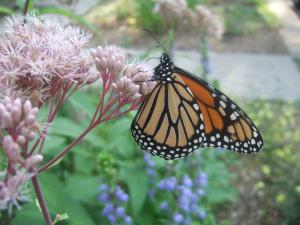Introduction
The information below is intended for local governments working with Minnesota Board of Water and Soil Resources (BWSR) funding and summarizes key steps for incorporating pollinator habitat and biodiversity into BWSR Programs.
Toolbox Home
Clean Water Fund
- Assess project type, goals, plans, and landowner objectives to determine if pollinator/insect habitat is a practical addition to the project.
- Assess site for protection from potential impacts (pesticides, contamination, etc).
- If the site is suitable for pollinators, discuss how pollinator habitat and biodiversity will be included as part of the project in the grant application and, for projects that are funded provide detail about the pollinator/insect habitat in the work plan, and planting plan.
- Incorporate plant species that will provide pollinator floral resources through spring, summer, and fall using the plant selection portion of this toolbox for guidance.
- Plan for appropriate maintenance to sustain diversity over time.
Reinvest in Minnesota (RIM)
Existing RIM Projects
- Check availability of RIM Enhancement Funding with local SWCD staff to improve habitat for pollinators/insects on existing easements.
- If the plan includes inter-seeding (see BWSR guidance), or a new seeding is planned, ensure that sufficient site preparation is done to allow for seedling germination.
- Following inter-seeding, conduct mowing to aid seedling growth.
New RIM Projects
- Follow BWSR's Native Vegetation Establishment and Enhancement Guidelines. for project diversity guidelines and seed specifications. An NRCS seed calculator has been developed to benefit Monarch butterflies and other pollinators/insects as part of CREP plantings using the 643 practice standard.
- Discuss availability of funding to plant pollinator plots (areas of higher diversity protected from pesticides) as part of projects with SWCD and BWSR staff.
- Assess sites for protection (e.g. buffer) from pesticides. See the fact sheet on Protecting Conservation Lands from Pesticides (pdf).
- When restoring pollinator habitat, incorporate plant species that will provide pollinator habitat and biodiversity through the seasons.
- Plan for appropriate maintenance to sustain diversity.
State Conservation Contracts Grant Program
- Assess project type, goals, plans, and landowner objectives to determine if pollinator/insect habitat is a practical addition to the project.
- Assess site for protection from potential impacts (pesticides, contamination, etc).
- If the site is suitable for pollinators, discuss the pollinator component of the project in the grant application, work plan, and cost-share agreement as appropriate. Provide detail in the planting plan.
- Incorporate plant species that will provide pollinator/insect habitat through spring, summer, and fall.
- Plan for appropriate maintenance to sustain diversity.
Wetland Mitigation
- Determine the plant communities to be restored and how pollinator habitat can be incorporated as part of the project. Determine if specific seed mixes can be used that are beneficial to pollinators/insects or if species can be added that will provide pollinator/insects benefits.
- Assess site for protection from potential impacts (pesticides, contamination, etc). Assess whether there are portions of the project that are more protected and would provide opportunities for adding more diversity (pollinator zones).
- Incorporate plant species that will provide pollinator habitat through Spring, Summer, and Fall.
- Plan for appropriate maintenance to sustain diversity.
Habitat Enhancement Landscape Pilot (HELP)
- Become familiar with the HELP program on this webpage, including future RFPs. HELP is focused on restoring and enhancing diverse native habitat on conservation lands and natural areas strategically located across Minnesota to address declining pollinators and other beneficial insects.
- Assess opportunities to maximize habitat for beneficial insects using the program’s planning template and the Pollinator and Biodiversity Toolbox.
- Assess site for protection from potential impacts (pesticides, contamination, etc).
- Incorporate plant species that will provide habitat through spring, summer, and fall.
- Plan for appropriate maintenance to sustain diversity.

